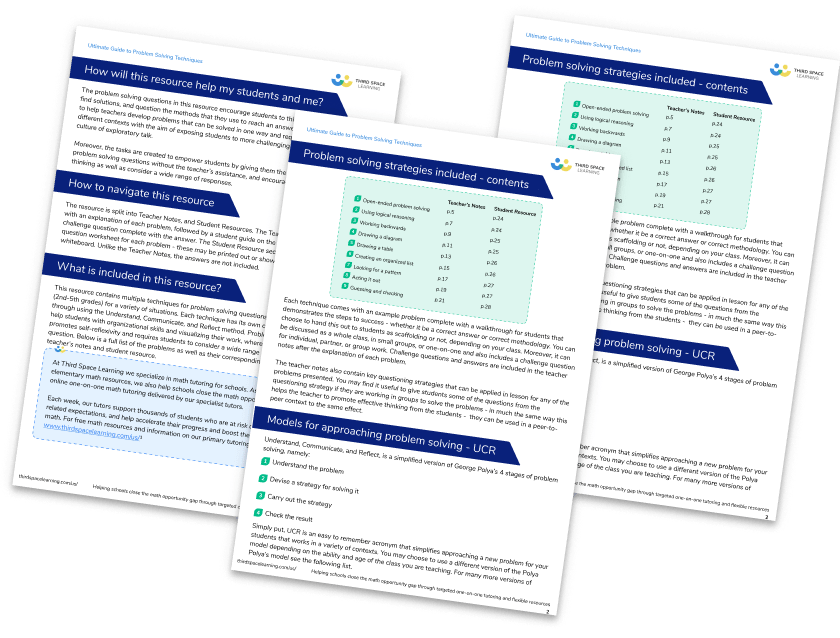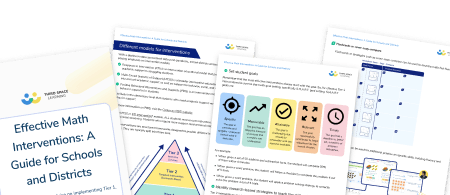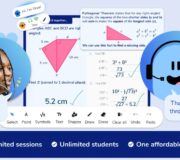Causes Of Math Anxiety And Proven Strategies To Overcome Them
Aidan is a math curriculum lead-the last person you’d suspect of being anxious around math. And today, he doesn’t suffer form math anxiety. But that wasn’t always the case. In school he found every excuse to avoid completing his math work because the anxiety was crippling.
Math anxiety is linked to lower math achievement-it needs attention. Here’s what Aidan learned about overcoming math anxiety and how, as a math curriculum lead, to ensure the students in his school overcome it too.
From tortuous to teaching: conquering math anxiety
I remember finding ways to get out of math lessons as a kid
My favorite trick was to offer to tidy up the teacher’s cupboard – I even clearly remember stacking the math textbooks neatly on the shelves, feeling inwardly smug that I didn’t have to open them and attempt the questions inside.
I recall my dad spending what seemed like hours with me trying to help me to understand negative numbers and how to calculate them – unfortunately, his pictures of eggs and eggcups didn’t help at all although I appreciated his efforts!
My relationships with my middle school math teachers were never great – firing a huge elastic band into their eye really didn’t help (will always regret that) and spending most of the time chatting to literally anyone I was moved to sit with wasn’t exactly productive either.
In fact, in middle school, I hated math.
It was only when I became a teacher, and had to teach math, that I began to understand math for myself.
In order to teach it to my students, I had to know what I was talking about. By breaking things down into small steps and striving to understand the inner workings of the mathematical processes I was teaching, I became much more confident in math.
In fact, I’ve spent the last three years leading on math throughout the school and have written many articles about how to teach elementary math – that’s progress!
It’s also an encouragement: math anxiety can be overcome.
But before we look at how to overcome it, let’s look at the facts and figures surrounding math anxiety.
This is a fantastic video from the team at childline which explains what anxiety is in child friendly terms.
Effective Math Interventions: A Guide for Schools and Districts
Get practical strategies to help children overcome their fears and succeed in math. A guide for school leaders, administrators, and interventionists on implementing successful math interventions.
Download Free Now!What is math anxiety?
Before we jump to conquering mathematics anxiety, let’s first define it. Some of you who have never experienced it may even be wondering if math anxiety is a real thing.
Sure, some people may feel a bit nervous when faced with a math problem, or even have a dislike of math, but that doesn’t always equate to math anxiety.
“Math anxiety is a negative emotional reaction to mathematics, leading to varying degrees of helplessness, panic and mental disorganization, that arises among some people when faced with a mathematical problem.“
Math Anxiety Trust
Some people reading that statement may be sitting there saying ‘That’s me!’ If you’re not but you’ve ever frozen at the thought of having to answer a math question, getting the answer or method wrong, you’ve likely experienced math anxiety too.

Meet Skye, the voice-based AI tutor making math success possible for every student.
Built by teachers and math experts, Skye uses the same pedagogy, curriculum and lesson structure as our traditional tutoring.
But, with more flexibility and a low cost, schools can scale online math tutoring to support every student who needs it.
Find out moreWho is at risk of developing math anxiety?
According to an EdWeek study, it is estimated that 1 in 5 adults in the US has high math anxiety and 1 in 4 teachers often feel nervous doing math themselves!
67% of the teachers surveyed reported math anxiety as a big challenge for their students.
This means that not only are our students feeling panicky with math, but some of their teachers are as well.
In fact, some research shows that when teachers experience math anxiety they can pass it on to their students, especially in the case of female teachers and female students. This is supported by recent research from Cambridge University which found gender differences in math anxiety. The report indicated that girls are more likely to report math anxiety than boys, even after controlling general anxiety.
This shows just how far-reaching math anxiety is and why we as school leaders and educators need to pay it more attention.
“Teachers, parents, brothers and sisters and classmates can all play a role in shaping a child’s maths anxiety.”
Ros McLellan, Understanding Mathematics Anxiety.
Recognizing math anxiety
Math anxiety is more than just a lack of confidence in tackling a new and harder problem in math.
At a most basic physical level, children often try to do anything to avoid being anywhere near any kind of math – my hiding in a small closet was a classic version of this!
Classic physical symptoms include shaking, sweating, nausea and any nervous reactions like nail biting or lip biting.
A sense of helplessness is common and can lead to shutdown where a child stops listening or even trying
Confusion and frustration may then lead to crying and raging
Feelings of tension and extreme stress before and during exams may be such that additional time and support may be required
Does math anxiety affect mathematics performance?
A 2018 Ipsos MORI poll found that 23% of parents of children aged 5-15 report that their eldest child often feels anxious when attempting to solve mathematical problems, and that math anxiety seems to be affecting the more recent generations.
Why?
Math is objective. The answer is right or wrong. When solving mathematical tasks you either make an error or you don’t. There’s no room for subjectivity like there is when you write an essay which can ease the pressure. In some ways, the line between math anxiety and test anxiety blurs here.
“With math, you can make a mistake and get it wrong. And that can be especially anxiety provoking,” Colleen Ganley, Developmental and Educational Psychologist, Florida State University.
The study found that 36% of younger (15-24 year-olds) people feel anxious about math, compared to 10% of older people (65+). Some studies suggest children can develop math anxiety at a very early age when they are learning basic number skills.
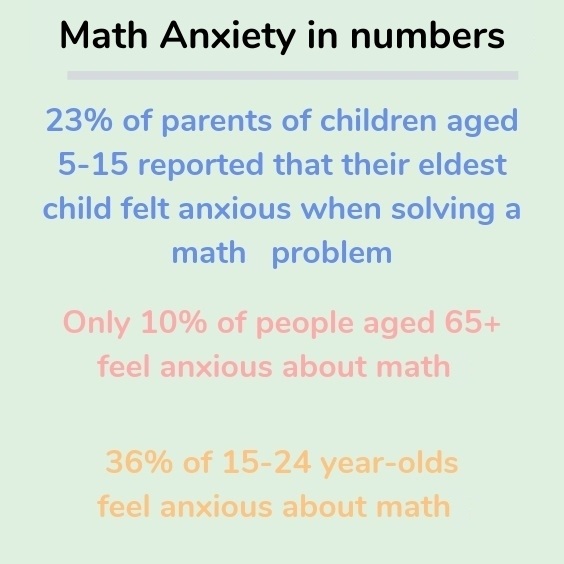
Math often causes more anxiety than other school subjects
Many point out that we don’t treat reading the same as we do math. For example we don’t say
“Oh I was never any good at reading.”
or
“Reading is too difficult for me.”
And yet, many of us say the very same things about math.
Is this a result of math anxiety, or do these attitudes contribute to math anxiety?
What causes math anxiety?
Does poor math performance lead to math anxiety or does math anxiety lead to poor math performance?
Math anxiety vs math performance
Three psychological science theories link math anxiety and math performance:
Poor math performance leads to higher math anxiety (deficit theory).
Math anxiety leads to poor performance in math (anxiety model).
A vicious cycle: higher anxiety contributes to poor performance; poor performance contributes to higher anxiety (reciprocal theory).
Pantoja et al. (2020) found math anxiety at the beginning of first grade predicted kids’ math achievement in first through third grades, above and beyond their foundational math skills. Meaning, math anxiety can impact future learning.
However, evidence suggests this works both ways. What is known is that they are linked: if a child suffers from math anxiety, they are more likely to perform poorly; if a child performs poorly, they are more likely to suffer from math anxiety.
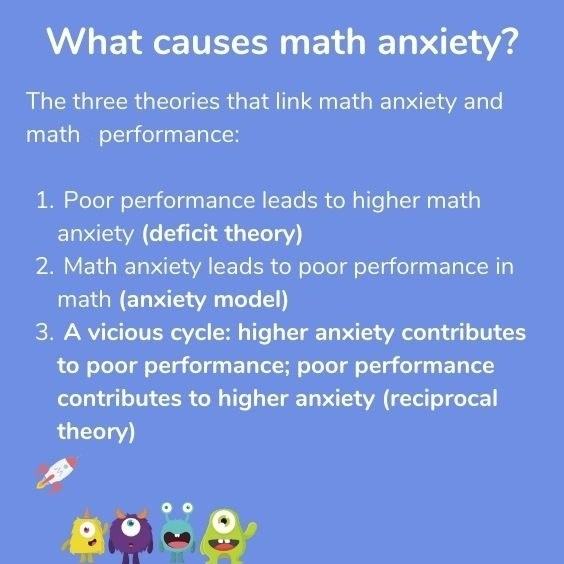
Beliefs vs skills
Still today, many stereotypes class math and STEM subjects as a ‘male-dominated’ which could impact the way female students even approach math classes and math tasks.
Beyond gender, students’ internal narratives, math self-concept, lack of belief in their math ability and negative attitudes could be increasing their math anxiety.
It’s crucial that educators build math confidence in their learners and a safe, engaging learning environment for them to learn to enjoy their math education.
READ MORE: Famous Female Mathematicians
Overcoming math anxiety
So what do we do for those children who, like a younger me, look at a math problem and just see a swimming blur of numbers and symbols and feel a sickness in the pit of their stomach?
How do we help those who feel overwhelmed by a math question to the point where they just want to cry out in anguish?
Fortunately, there are a number of things teachers and parents can do.
8 strategies to overcome math anxiety
1. Identify math anxiety
The best thing leaders and educators can do is to be on the lookout for math anxiety. By simply identifying it at an early stage of a child’s mathematical development, you will be better placed to support them.
2. Adapt and differentiate
In class, your role is to be ready to adjust and adapt your math pedagogy and teaching approach to accommodate the potential triggering of high levels of math anxiety.
Be aware of the demands that learning new content can place on working memory and ensure that, wherever possible you design your activities with cognitive load theory in mind. If a student starts to experience cognitive overload this can trigger math anxiety symptoms.
Break new teaching moments down into their smallest components so that your learners can continue to have small wins on their way to experiencing challenge.
3. Build confidence
Build up confidence with some standard definitions and ways of explaining math instruction so that children can start to internalize and know by heart. Sentence stems, math dictionaries for kids and vocabulary lists or walls are fantastic for this.
Providing lots of practice opportunities, particularly through example problem pairs enables children to feel supported and reduces math anxiety as they progress.
Third Space Learning’s one-on-one high impact tutoring sessions help reduce math anxiety. Skye, the AI math tutor, breaks math concepts down into small bite-size chunks to help students become more confident with the math concepts they struggle with.

4. Manipulatives
Don’t be afraid of providing additional concrete resources even for middle and high school students when working on manipulation of numbers. By starting from the concrete you can ground students’ understanding of a new math idea and then move gradually from this to a more conceptual understanding.
5. Math interventions
Where budgets allow, dedicated one to one math interventions, such as those provided by Third Space Learning, are the gold standard in breaking through math anxiety barriers. Tutors are trained to support, coach and nurture an anxious child through their online math lesson one standard-aligned math concept at a time.
6. Make math interesting
Rather than completing math question after question introduce chances to develop math talk about and explore math.
Most board games, and many computer games, feature lots of math opportunities. Project-based learning is a great way to make math more interesting for students.
There is some evidence that enjoyment is a good motivator and that children learn when they are happier so it is worth making math into something that is fun!
7. Discuss math anxiety
A problem shared is a problem halved (nice mathematical saying there). Encourage learners to talk about their math anxiety- let them know that it’s OK to feel that way about math-related tasks or math tests. If they talk about it, you can put strategies in place to prevent math anxiety.
It seems that, for children who suffer from math anxiety, it is a good idea to do this directly before they attempt any math – some research has shown that doing this helps people to go on to be more successful in the math task at hand.
Children should be allowed to verbalize their feelings – often this can make them feel less like they are the only one who struggles. This is the same for children experiencing test anxiety.
Simply trying to quash any anxieties around math is not a healthy way to deal with these feelings.
And remember, if it is indeed good to talk, it is also good to listen when children share these anxieties – ensure that they know and feel that they have been heard.
8. Encourage questions
Oftentimes, struggling mathematicians find it easy to hide their difficulties, finding ways to cope which don’t ever result in a better understanding – cue cleaning the teacher’s cupboard like I did!
To help children not to resort to these, encourage the idea that it is OK to ask for help and that it is OK to make mistakes. Reinforce the idea that we learn when we make mistakes and we learn when we ask for help.
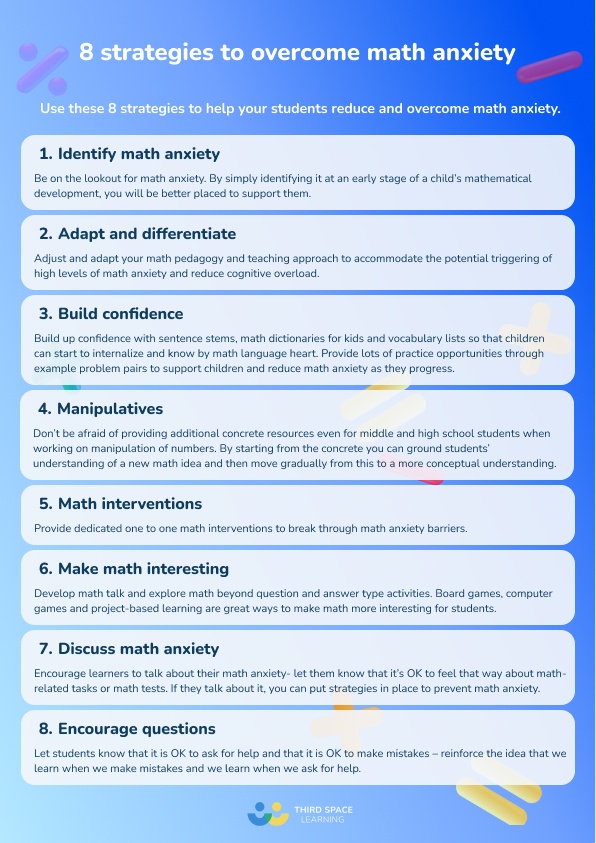
Improving math anxiety outside of school
Math anxiety doesn’t only happen in school, nor can it solely be fixed during school hours. Everyone can help students overcome their math anxiety. Reducing math anxiety is a joint effort between schools and families.
Encourage parents and carers to help learners with their math anxiety at home too. You may wish to hold a meeting or communicate a letter encouraging student’s families to incorporate the ideas below. Some of these math practices can be used in class too.
1. Regular practice, little and often
Parents sometimes expect too much of children at home after a day at school. While it is important to practice, ensure they don’t push their child into doing too much. This can be counterproductive.
10 minutes a day is better than one grueling 45-minute session on a Sunday afternoon. This 10-minute math activity is a prime example of something that can be set for homework.
This repeated, daily practice complements what we know about how we learn best. If we regularly recall something, drawing it out of our memory we are more likely to remember it for longer.
We also know that we can suffer cognitive overload in our brains if we try to do too much. Especially too many different things. Try to keep the work focused on one or two mathematical concepts at a time.
2. Practice only what has been taught in school
Stress to parents not to teach new things at home. Math homework for elementary-aged children works best when it is a follow-up of work that they have already done at school. And, when it is done with a parent the way it was taught in class.
3. Make math a part of everyday life
Parents have a real opportunity to make math real – arguably even more than teachers do at school.
For example, when out and about in ordinary life, going to the grocery store, doing DIY jobs, cooking in the kitchen, and so on, there are plenty of opportunities to have math-based discussions. These don’t always have to include questions.
Encourage parents to help learners to:
- Understand coin denominations when giving pocket money.
- Ask them what the time is and talk about how long it will be until dinnertime.
- Discuss at dinner how, if five people are eating and have three pieces of cutlery there will be 15 pieces of cutlery.
Provide parents with a quick sheet of real-world math opportunities they can look out for every day.
When you start to look for math opportunities in everyday life you will start to notice them everywhere!
4. Don’t pass on your own anxiety
You hear it all time-you might even say it yourself “Oh, I’m not a math person, I was really bad at math when I was at school.”
This advice goes for teachers too, don’t tell learners that you were bad at math.
This will only make them think that it is a legitimate thing to think and say.
You want them to feel like they can be good at math, and that there are no reasons as to why they shouldn’t be. Ensure that they know this and help them to maintain a positive attitude, even when the going gets tough!
Try developing some growth mindset affirmations (or Mathirmations, if you will!):
“I CAN learn my times tables.”
“I WILL be able to find fractions of amounts.”
“There is NO reason why I can’t be awesome at math!”
Get them to practice saying them aloud – positive self-talk may help here.
5. Communication
As important as it is to communicate with your students’ families, they need to be encouraged to communicate with you too.
Make them feel like they can come to the school or teacher if their child is suffering from math anxiety. Discuss with them potential strategies for both home and school and work in a partnership.
Parents may be able to help you understand something about their child that perhaps you aren’t aware of.
By working together, you will have the best chance of helping learners deal with, and overcome, math anxiety.
Math anxiety key takeaways
Math anxiety poses a significant challenge that over 67% of students need to overcome. But it is possible.
As school leaders and educators, we have a responsibility to create environments where math anxious individuals can be identified early and addressed effectively.
We can help students build confidence in their mathematical abilities by implementing stratgegies such as:
- Breaking math down into manageable chunks
- Using manipulatives
- Encouraging math talks and discussion
- Maintaining communication with families
Remember that overcoming math anxiety isn’t just about teaching math differently—it’s about changing the entire narrative around mathematics. When we stop saying “I’m not a math person” and start promoting growth mindset attitudes, we create a more positive mathematical culture in our schools.
Through consistent support, adaptive teaching approaches, and strong home-school partnerships, we can help every student develop a healthier relationship with mathematics.
Math Anxiety FAQS
According to the Math Anxiety Trust, math anxiety is a negative emotional reaction to mathematics, leading to varying degrees of helplessness, panic and mental disorganization, that arise among some people when faced with a mathematical problem. It is a feeling of fear and nervousness associated with mathematics.
Look out for students who may:
1. Appear flustered
2. Be unsable to concentrate
3. Stay silent durning math class
4. Avoid doing math
Students experiencing math anxiety may also become sweaty and feel nauseous.
Do you have students who need extra support in math?
Skye—our AI math tutor built by experienced teachers—provides students with personalized one-on-one, spoken instruction that helps them master concepts, close skill gaps, and gain confidence.
Since 2013, we’ve delivered over 2 million hours of math lessons to more than 170,000 students, guiding them toward higher math achievement.
Discover how our AI math tutoring can boost student success, or see how our math programs can support your school’s goals:
– 3rd grade tutoring
– 4th grade tutoring
– 5th grade tutoring
– 6th grade tutoring
– 7th grade tutoring
– 8th grade tutoring
The content in this article was originally written by primary lead practitioner Aidan Severs and has since been revised and adapted for US schools by elementary math teacher Christi Kulesza.
